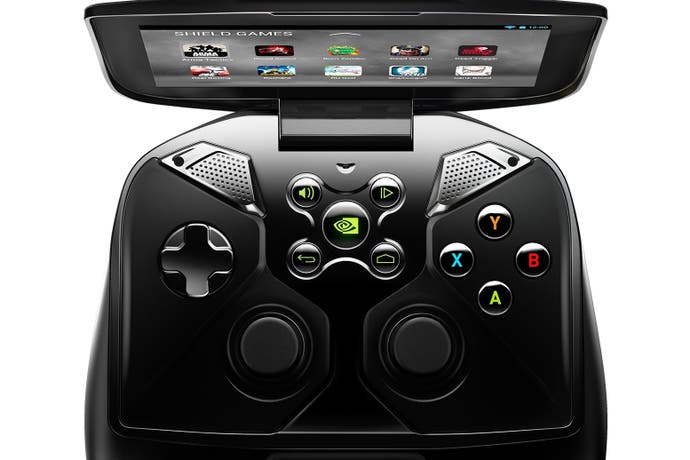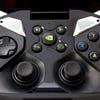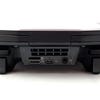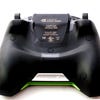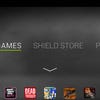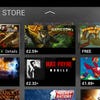Nvidia Shield review
The ultimate in Android and portable PC gaming?
Let's cut straight to the chase: Nvidia Shield is a superb, state-of-the-art handheld product - the most powerful Android hardware on the market right now - integrated into a beautifully built controller that ranks alongside the Xbox 360 pad in terms of ergonomics and response, while exceeding it in terms of the quality and feel of the materials. Shield isn't perfect, but for a first attempt at a handheld console from a firm known for graphics technology, it's a stand-out effort.
Shield isn't available in the UK at the moment, but the small matter of an ocean was never going to trouble Digital Foundry, so here we are with an American unit we imported. On first removing the device from the packaging, impressions are a little mixed - on the one hand, there's an immediate sense of the quality in the build and materials, particularly from the rubberised underside of the unit which fits into your hands with a reassuring level of grip. It's a somewhat solid beast, weighing 579g - over twice the weight of PlayStation Vita - but integrating that sheer mass into what is essentially an Xbox 360 pad design with a clamshell flip-up display pays off: your hands wrap around the contours of the underside perfectly, and while Shield definitely makes its presence felt in your grasp, the weight distribution ensures that there's little danger of any fatigue, even after a couple of hours of sustained play.
Prising the lid open reveals the 1280x720 5-inch "Retinal" display, featuring excellent viewing angles and a 294ppi pixel density (up against Vita's 960x544 220ppi screen), marred only by an outsize bezel and a glossy coating that attracts fingerprints and makes outside viewing very difficult. There's a curious disparity in the balance of the design in terms of the size of the screen versus the controller element - it just looks too small, and we couldn't help but wish that the display occupied some of the area taken up by the intrusive bezel.
Disappointment with the screen is offset somewhat by the quality of the control interface. What we're dealing with is a full-size joypad with zero compromise to the design - the 360-style analogue sticks feel a little weightier than the standard Microsoft config, but have plenty of travel and feel right, and retain 'press to click' L3/R3 functionality for full gaming compatibility. The ABXY face-buttons feel equally good, and an additional cluster of five centrally mounted buttons combine additional functions like instant access to the Shield area of the Android 4.2 OS and volume control along with standard Android navigation buttons. Clickable shoulder buttons are part of the package, along with the requisite analogue triggers, while the d-pad is a rolling type, similar to the Sega Saturn's, and works just fine. Perhaps the biggest surprise is the quality of the integrated stereo speakers. There's the understandable lack of bass, but at max volume they're reassuringly loud.
Moving to the back of the Shield we find a MicroSDXC slot for additional expansion, micro-USB, mini-HDMI and a standard 3.5mm stereo jack for headphones. Above the IO interfaces is a genuine surprise - an air-vent. Remarkably, Shield features active cooling in the form of a fan for the Tegra 4 chipset. Were it not for the presence of the exhaust, we'd have no idea that there's any kind of active cooling in effect at all - Shield is virtually silent in operation (even under load) and actually cooler in your hands than the iPad 4 after intense 3D gaming.
Make no mistake, Shield is designed by Nvidia to showcase Tegra 4 in optimal conditions. The presence of the cooling solution means that the firm pushes the processor to the top end of its capabilities. Tegra 4 features a quad-core ARM Cortex A15 running at 1.9GHz, with a fifth core, a much slower A15 "companion core" that handles less power-intensive tasks. The graphics core features 72 cores (compared to Tegra 3's 12), but frequency here is unknown.
The benchmark results are clear enough though - best-in-class performance across the board, easily surpassing the top Android devices. The question is, to what should we compare Shield? Smartphones or tablets? We couldn't make up our minds, so decided to run the benches up against our existing phone database, and to replicate the tablet tests we ran when we reviewed the x86/Kepler-powered Razer Edge tablet. In terms of CPU performance, the quad-core A15s blitz every other mobile product on the market, while graphics effortlessly power past the Samsung Galaxy S4 and the Nexus 10. Only the iPad 4's enviable GPU power gets close.
The net result is that Shield runs the Android 4.2 operating system beautifully with only a combination of heavy multi-tasking and several RAM-intensive applications resident in memory causing any kind of impact to performance. What we found particularly impressive was the sheer speed of the browsing experience. While Shield's clamshell design isn't a natural fit for browsing, it really comes into its own if you attach a USB hub with a keyboard and mouse, offering something approaching a desktop experience when it comes to surfing the web. Based on our experience, the hardware seems like a good fit not just as a mobile gaming machine, but also perhaps as a portable mini-PC for browsing and productivity.
Shield's dominance in gaming benchmarks comes down to two factors: its considerable graphics power, along with the fact that it only needs to service a 720p resolution rather than the 2.5x boost found on the 1080p displays incorporated into the latest and greatest smartphones. Based on its benchmarking prowess, we were expecting something close to a locked 60 frames per second on any 3D Android game we threw at it. The reality was somewhat different though - Shield is bundled with the Tegra-enhanced version of Sonic the Hedgehog 4 Episode 2 and twin-stick shooter Expendable Rearmed and both operate at native 720p, and while frame-rates are high, split-second drops in performance separate this from the typical console standard where consistency is far more pronounced.
"The benchmarks are simply phenomenal but the gameplay experience on cutting-edge Android titles is let down a touch by some inconsistent frame-rates."
| Nvidia Shield | iPad 4 | Nexus 10 | |
|---|---|---|---|
| Geekbench | 4335 | 1773 | 2345 |
| Sunspider 0.9.1 (Java) | 396.3ms | 840.8ms | 873.3ms |
| Kraken 1.1 (Java) | 7192.7ms | 16699.9ms | 7930.5ms |
| GFX Bench 2.7 T-Rex HD (offscreen) | 24fps | 16fps | 12fps |
| GFX Bench 2.7 Egypt HD (offscreen) | 65fps | 50fps | 39fps |
| 3DMark Ice Storm | 19527 | - | 7769 |
| 3DMark Ice Storm Extreme | 11476 | - | 5258 |
Slash-'em-up Blood Sword: Sword of Ruin (enhanced with Tegra 4 in mind, apparently) makes a much stronger case for the locked 60fps, as does older game Dead Trigger. While performance is variable, GTA Vice City runs nicely with all settings enabled, quality at max and draw distance ramped up as far as it goes. Real Racing 3 exemplifies some of the issues Shield faces: lack of support for physical controls in many games and, again, rapidly fluctuating frame-rates. There are moments where Fire Monkeys' demanding racer switches up a gear into a pure, wondrous 60fps experience, but split-second drops down to 45/30fps are unfortunately commonplace.
The overall impression we get from Android gaming on Shield is a little mixed. It's clear the power is there: in our test games, average frame-rates blitz the Galaxy S4, but in many cases we can see that the games are not optimised for the platform, and that's a key disadvantage compared to dedicated mobile gaming platforms like the Nintendo 3DS or the PlayStation Vita. Working to a fixed platform with an SDK designed with a razor-sharp focus on gaming is something that Android doesn't have, and it's a touch disappointing that even the TegraZone games have the same issues with fluctuating performance.
You'll see the same thing on virtually all Android devices, of course, but the difference is that gaming is just one element of the smartphone or tablet proposition whereas it's the primary purpose of Shield, where we demand a higher standard and better consistency in the gaming experience.
Overall, there's the sense that the performance of the software - while best-in-class by Android standards - doesn't quite have the polish to match Nvidia's hardware. Shield itself is beautifully crafted and highly polished, in stark contrast to much of the 3D library, even those titles Nvidia itself has chosen to showcase. There are no real problems with 2D titles of course, but the vast majority of those games will run just as well on a variety of tablet and smartphone hardware.
"Welcome to the next generation in mobile performance. The Tegra 4 chipset comprehensively beats any current smartphone or tablet in both CPU and graphics benchmarks."
| Nvidia Shield | Galaxy S4 | Xperia Z | HTC One | Nexus 4 | Galaxy S3 | |
|---|---|---|---|---|---|---|
| Quadrant Standard | 18396 | 12346 | 7175 | 12488 | 4906 | 5127 |
| AnTuTu Benchmark | 41014 | 23578 | 20694 | 24374 | 10580 | 11950 |
| Geekbench 2 | 4335 | 3109 | 2181 | 2816 | 2263 | 1716 |
| GFX Bench Egypt On-Screen/ Off-Screen | 59fps/ 65fps | 41fps/ 41fps | 32fps/ 32fps | 31fps/ 34fps | 39fps/ 31fps | 16fps/ 16fps |
| GFX Bench T-Rex On-Screen/ Off-Screen | 39fps/ 24fps | 15fps/ 15fps | 13fps/ 13fps | 13fps/ 15fps | 19fps/ 12fps | 4fps/ 6fps |
| 3D Mark Ice Storm 720p/ 1080p | 19527/ 11476 | 10454/ 6730 | 10114/ 5853 | 10054/ 6297 | 11019/ 6400 | 3225/ 2321 |
Of course, the gameplay story doesn't end with Shield's Android performance - it can stream PC titles too via a standard Wi-Fi connection, as long as you have a GTX 6xx series graphics card in your system. Gameplay streaming itself is still in beta, but despite that it's fairly robust. Connect Shield and your GTX 6xx-equipped PC to the same network, use Shield to connect and a pairing prompt appears on the PC screen. After that, the handheld can be used to select any compatible game that's installed onto your PC, and there's access to Steam's Big Picture mode too.
Everything you need to know about Shield's PC game streaming
Bearing in mind some of the aggravation we've had in the past with media servers across our network, the ease of connection was remarkable - Shield even managed to connect to a PC in another building entirely, connected to our router via power line networking. We should point out that our own testing was carried out with a router that's not on Nvidia's recommended list, but we compared findings with another user with the required kit and the overall experience was very similar indeed. We tested latency in best-case conditions in the lab, with the PC attached to the router via an Ethernet cable, with Shield just 2-3m away operating over Wi-Fi 802.11n.
We've measured latency before on "gameplay over IP" systems like Gaikai and OnLive, but this experiment is unique in that we have access to both server and client in the same room, so we capture both running simultaneously and use a high-speed 60fps camera to record our control inputs, with both PC and Shield displays in-shot. Our game of choice is BioShock Infinite, running on PC with a Core i7 at 4.3GHz and a GTX 670 graphics card. Frame-rate is initially unlocked, with FRAPS indicating that the game is running at over 200 frames per second.
Latency results are impressive here: control signals from Shield are processed and displayed on-screen in 50ms - with the handheld feeling almost like a local controller. The response is encoded, beamed back to Shield and decoded in a further 50ms, giving a 100ms round-trip latency in total. Turning on v-sync in-game, and capping frame-rate to 60fps gives an identical response on both legs of the journey. In an effort to try out other gaming conditions, we switch the host PC to Wi-Fi and downgrade from 802.11n to 802.11g. Here the difference is definitely felt, with an extra 33ms added to latency.
Overall though, a 100-133ms response is ballpark with current-gen 30fps console games, which isn't too bad and the result is a clearly playable experience. However, performance is likely to vary according to Wi-Fi strength - something that will almost certainly apply to PS4's Vita Remote Play hook-up too.



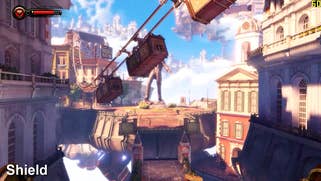
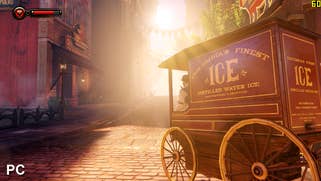
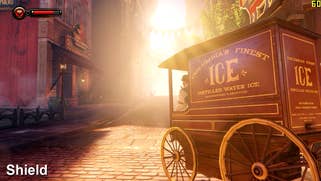

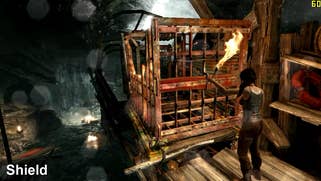
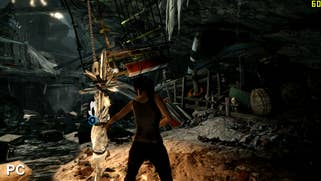

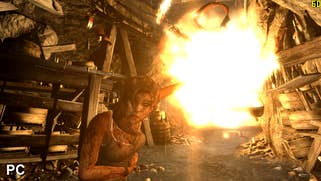

In terms of image quality, the GeForce/Shield hook-up isn't bad at all. We seem to be dealing with a 6-7mbps image transmitted at native 720p, and while it's safe to say that image quality isn't as pristine as, say, the Wii U GamePad, the overall effect is still pretty decent, with only occasional scenes causing the GTX h.264 hardware encoder any real issues. The fact that the image is being displayed on a 5-inch display with a very high pixel density also helps a great deal - it's similar to running a YouTube 720p HD encode in the standard webpage window. What is curious is that you can run your PC game with the frame-rate completely unlocked - as we did with BioShock Infinite - and while screen-tear appears PC-side, on Shield the result is a completely v-synced image. The encoder only appears to process complete frames, as opposed to the unlocked output from the video port.
What is a touch disappointing is the performance level. OnLive made efforts to stream 720p imagery at 60 frames per second. On our BioShock test, we were running the game anywhere from 120 to 220fps on our GTX 670, yet the Shield stream appears to sit somewhere in the 30fps region. A typical console game delivers 30 frames per second with a consistent cadence - a new frame, a duplicate, a new frame, a duplicate, and so on. However, the incoming h.264 stream lacks this consistency, with multiple new frames or dupes arriving consecutively, causing some judder. Enabling v-sync PC-side in-game locked the performance level to 60fps, but we saw no improvement in Shield-side performance or consistency - perhaps it is a router issue, though we should note that OnLive titles that run at 720p60 server side seem just as smooth here.
"With a 100ms input latency and a 720p30 update, PC game streaming on Shield is remarkably similar to the current-gen console gaming experience."
What is interesting is that while the GeForce Experience software sets resolution to 720p, there's nothing to stop you changing display res - or indeed any other setting - in-game. We set BioShock to 1080p and got a perfectly downsized image, effectively allowing us to use the additional power of the GTX 670 for super-sampling anti-aliasing. However, the downside of this is that option menus are much more difficult to navigate owing to their reduced size, and the image quality benefits of the super-sampling are easily nullified by the quality of the encoding. While the 720p30 target output is a little disappointing, a more positive way of looking at it is that far less capable GPUs than the GTX 670 should still be able to produce decent results. We ran BioShock Infinite and Tomb Raider at 720p on ultra settings, but the image compression in combination with the frame-rate cap and the very small screen suggests that the streaming experience could be fairly level across a large range of GTX cards of all budgets.
We played through sections of BioShock Infinite and Tomb Raider and came away impressed more by the experience rather than the technological nuts and bolts. The ability to decouple PC gameplay from the office/den and play wherever you want in the home generally works well very well indeed, and provided you have powerful Wi-Fi, there should be much more range here than with Wii U GamePad off-TV play. The Shield itself supports dual-band 802.11n, so it's good to know that Nvidia hasn't skimped on the handheld's Wi-Fi capabilities.
The streaming element of the Shield package is flagged as a "beta" and hopefully Nvidia will continue to work on it. Clearly there are areas for improvement - we'd like to see target frame-rate and bandwidth selectables, so we can tailor the experience to match the quality of our Wi-Fi, and a stronger focus on video consistency would help a great deal too. We'd also like to see more titles supported too, something Nvidia promises is coming once the tech moves out of beta.
What we have for now though is an extremely promising beginning. PC gaming is indeed 'portable' in the way that Nvidia envisaged, and it's now clear to see why Valve's Gabe Newell believes that latency isn't an issue for the low-end streaming Steam Boxes that are (apparently) in development, because response here is a match for current-gen console in our testing. While latency on OnLive was clearly an issue, relocating the "gameplay over IP" concept into the home clearly works well, and after the Shield experience we can't wait to test out the PlayStation 4 rendition of the same core technology.
"There's a clear hit to image quality in the PC streaming mode, but the small, high pixel density display works well in making the macroblock artefacts hard to pick up on for the most part."
Nvidia Shield: the Digital Foundry verdict
It's difficult not to be impressed with the entirety of the Shield experience. We love the zero-compromise approach to the controller design, and the fact that Nvidia has unashamedly targeted the core gamer for its debut games machine. Shield is undoubtedly a niche product and clearly won't be the best buy for everyone, but at the same time we couldn't help feel that this was a handheld built for us.
There's certainly plenty of power on tap. The Tegra 4 chipset is operating at the height of its potential - four ARM Cortex A15s running at 1.9GHz produces blistering performance when compared to the current top-tier Android devices, and right now Shield's overall performance is simply in a class of its own. Also noteworthy is battery life - in gaming, Shield's 28.8Whr battery is good for six hours, while the small display means that browsing and video playback stamina easily outstrips virtually any tablet or phone on the market. We didn't try it but suspect that the combination of sheer processing power on offer and those excellent controls should also make Shield one of the best platforms for emulation on the go, if that's your bag.
The ability to stream PC gameplay over an internal Wi-Fi network is another clear bonus, proving surprisingly robust across a range of networking scenarios. While frame-rates, refresh consistency and image quality could be improved, the quality of response from the controls is very good - highly playable and on par with current-gen console. This element of Shield is still in beta, but even in its current state, it's well worth checking out.
"Tegra 4 proves its worth in Shield, but Nvidia is already touting its next-gen Project Logan processor, which it says has more performance than PS3's RSX GPU."

Overall, as a first-gen effort, Shield is an excellent product, but it's difficult to avoid the sense that you're spending a lot of money on a high-end, ultra deluxe piece of niche hardware for a gaming ecosystem designed mostly for the casual market, and where the games aren't optimised to get the best out of the powerful hardware. Nvidia has helpfully published a list of joypad-compatible games, but most Android titles are designed with the touchscreen in mind and in this case, the clamshell, flip-up screen arrangement is not best suited to touch-orientated gaming.
There are exciting times ahead for mobile gaming. Nvidia's upcoming Project Logan brings about a stratospheric leap in power - even compared to Tegra 4. It also features support for graphics APIs used in the development of desktop PC games, suggesting that an era of convergence is coming - more advanced games could be deployed across computer, console and mobile. Suddenly, the Shield concept makes a lot more sense as a more mainstream mobile gaming platform.
In the here and now, the first-gen Shield is a gloriously niche, luxury product - the most powerful Android system on the market by a clear stretch and possessing a unique link to PC gaming that's seriously impressive in beta form, and can only get better.
